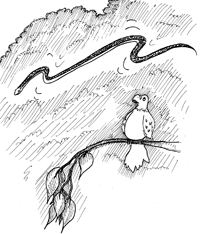STRANGE BUT TRUE- Leaping lizards: Well, there really are flying snakes

DRAWING BY DEBORAH DERR McCLINTOCK
Q. Warning: If you're afraid of snakes, this one could cause you nightmares for a lifetime. What's the decidedly eye-catching trick of "Chrysopelea paradise"? –J. Milton
A. The "paradise tree snake" can actually climb a tree and then, jumping from a high point, glide toward the ground, says Jearl Walker in The Flying Circus of Physics.
It can even alter its glide path during flight to take advantage of a new target (let's hope it's not you!), such as another tree. Hanging from a branch, the snake jumps upward and away, meanwhile straightening and flattening its bottom side to serve as an airfoil to provide lift– a little like a paper airplane.
However, after gaining speed, the snake does something quite different: It takes on an S-shape and then starts oscillating horizontally at about 1.3 times per second, adding extra lift and stepping up airspeed to 8 meters per second (18 mph) while in rapid descent. By tilting part of its body and shifting its oscillating head, the snake can change course in midair.
Q. "Conjoined twins" are the rarest of the rare, occurring only once every 100,000 births, with many dying within one day of being born. What's their biological basis? –T. & E.
A. Although most experts believe they arise from the division of a single embryo, some still maintain they result from the partial rejoining of two previously separate twins, says behavioral neuroscientist Mark Blumberg in Freaks of Nature: What Anomalies Tell Us About Development and Evolution.
While most conjoined twins are joined at the chest and abdomen, the world's most famous pair are Abigail and Brittany Hensel, born in 1990, with two heads, spinal cords, hearts, but only one pair of legs. Each twin primarily controls her own arm (a third awkward arm was removed soon after birth).
"Watching these girls swim, ride a bike, and dribble a basketball, my friends were as stunned as I was when I first saw them in action," Blumberg says.
Reportedly, when the two sisters cannot agree on a destination, paralysis sets in.
In the extraordinary case known as "fetus in fetu," one twin grows completely inside the other. When an Indian man with a huge belly developed trouble breathing at age 36, the surgeon opened him up looking for a tumor. Instead he found himself shaking a well-developed hand with long fingernails.
Then came more limbs, bones, etc., that under different circumstances could have cohered to form this man's twin brother.
Q. What's the "muzzle velocity" of a major league fastball, and what's the point of such terminology? –G. Triandos
A. The fastball may be the key baseball pitch, with the fastest of them crossing the plate at about 100 mph, says Robert Adair in The Physics of Baseball. In 1946, Bob Feller threw a pitch at 98.6 as it passed through a measuring trap about 60 feet away, though that was not muzzle velocity, or speed as it left the pitcher's hand.
Data generally show such velocity to be about 8 mph greater than when the ball crosses the plate, or a loss of about 1 mph every seven feet. So the Feller pitch must have "muzzled" at about 107 mph!
At such a speed, the ball will reach the batter in about .4 second, leaving little time to think or anticipate, let alone to watch the ball on its way in, since its angular velocity makes it impossible for the eyes to follow. An analogy: Just as at an airshow you can easily track for several minutes a plane flying at 20,000 feet, you cannot track for even a few seconds a jet plane flying 100 feet directly overhead (from Robert Watts and Terry Bahill in Keep Your Eye on the Ball).
~
Send Strange questions to brothers Bill and Rich at [email protected].
#